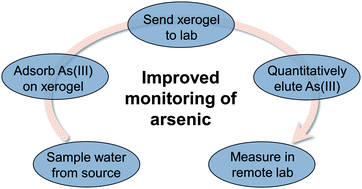Iron oxide xerogels for improved water quality monitoring of arsenic(iii) in resource-limited environments via solid-phase extraction, preservation, storage, transportation, and analysis of trace contaminants (SEPSTAT)†
Abstract
Arsenic is a widespread trace groundwater contaminant that presents a range of health risks and has an acceptable level of only 10 μg L−1 in drinking water. However, in many countries arsenic quantification in water is limited to centralized laboratories because it requires the use of elemental analysis techniques with high capital cost. As a result, routine water samples are frequently not tested for trace contaminants such as arsenic. In order to facilitate improved arsenic monitoring, we present the use of iron oxide xerogels for adsorption of arsenic(III) from water samples at neutral pH, dry storage for over 120 days, and desorption of stored arsenic at elevated pH. Iron oxide xerogels offer high surface area (340 m2 g−1) and an As(III) adsorption capacity of 165 mg g−1. Using an extraction solution of 100 mM sodium hydroxide and 1 mM sodium phosphate, As(III) is reliably eluted from iron oxide xerogels for initial As(III) concentrations from 10 μg L−1 to 1000 μg L−1, with a calculated detection limit of less than 4 μg L−1 and less than 17% difference in recovered As(III) between test solutions with low and high interfering ion concentrations. By demonstrating the ability for iron oxide xerogels to reliably adsorb, store, and release arsenic, we enable the development of protocols for solid-phase extraction, preservation, storage, transportation, and analysis of trace contaminants (SEPSTAT), where arsenic would be adsorbed from water samples onto xerogel-based sorbents and shipped to centralized laboratories for recovery and quantification.

- This article is part of the themed collection: Analytical Methods HOT Articles 2021


 Please wait while we load your content...
Please wait while we load your content...